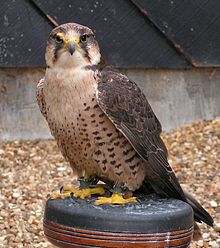Falco biarmicus
| Lanner falcon | |
|---|---|
 |
|
| Adult Falco biarmicus feldeggi | |
| Scientific classification | |
| Kingdom: | Animalia |
| Phylum: | Chordata |
| Class: | Aves |
| Order: | Falconiformes |
| Family: | Falconidae |
| Genus: | Falco |
| Subgenus: | Hierofalcon |
| Species: | F. biarmicus |
| Binomial name | |
|
Falco biarmicus Temminck, 1825 |
|
| Synonyms | |
|
Falco feldeggii Schlegel, 1843 |
|
Falco feldeggii Schlegel, 1843
Falco feldeggi Strickland, 1855 (lapsus)
The lanner falcon (Falco biarmicus) is a medium-sized bird of prey that breeds in Africa, southeast Europe and just into Asia. It is mainly resident, but some birds disperse more widely after the breeding season.
It is a large falcon, at 43–50 cm (17–20 in) length with a wingspan of 95–105 cm (37–41 in). European lanner falcons (Falco biarmicus feldeggi, also called Feldegg's falcon) have slate grey or brown-grey upperparts; most African subspecies are a paler blue grey above. The breast is streaked in northern birds, resembling greyish saker falcons, but the lanner has a reddish back to the head. Sexes are similar, but the browner young birds resemble saker falcons even more. However, sakers have a lighter top of the head and less clear head-side patterns. The lanner's call is a harsh "wray-e".
The lanner falcon is a bird of open country and savanna. It usually hunts by horizontal pursuit, rather than the peregrine falcon's stoop from a height, and takes mainly bird prey in flight. It lays three to four eggs on a cliff ledge nest, or occasionally in an old stick nest in a tree.
This is presumably the oldest living hierofalcon species. Support for this assumption comes mainly from biogeography agreeing better with the confusing pattern of DNA sequence data in this case than in others. Nonetheless, there is rampant hybridization (see also perilanner) and incomplete lineage sorting which confounds the data to a massive extent; molecular studies with small sample sizes can simply not be expected to yield reliable conclusions in the entire hierofalcon group. In any case, the radiation of the entire living diversity of hierofalcons seems to have taken place in the Eemian interglacial at the start of the , a mere 130,000–115,000 years ago; the lanner falcons would thus represent the lineage that became isolated in sub-Saharan Africa at some time during the Riss glaciation (200,000 to 130,000 years ago) already.
...
Wikipedia

